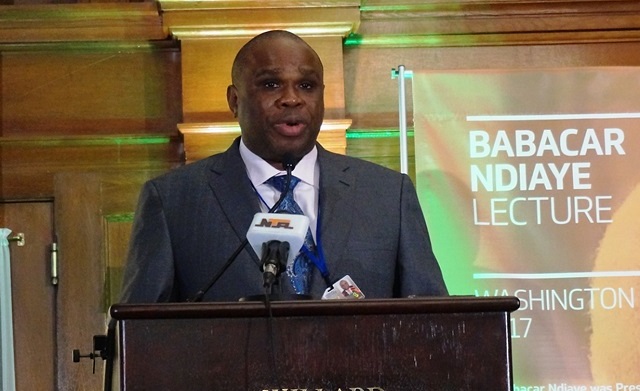
Most African countries rely on fossil fuels for energy and export revenue. Yet, development finance institutions, including the World Bank, are pulling back on fossil fuel investments
ANALYSIS | AGENCIES | The eighth annual Babacar Ndiaye Lecture, held at Washington D.C.’s Four Seasons Hotel on October 26, highlighted the pressing need for African nations to balance development imperatives with climate goals. Under the theme “Saving Lives Today versus Saving the Planet for the Future: Can the AfCFTA Resolve the Climate Change Dilemma?” the event explored how the African Continental Free Trade Area (AfCFTA) can drive both economic growth and environmental sustainability, positioning Africa as a leader in the global green transition.
Organized by Afreximbank and named after the late Dr. Babacar Ndiaye, the lecture series draws influential figures from across sectors to discuss Africa’s pressing economic and social challenges. This year’s session gathered policymakers, financial experts, climate advocates, and academics, setting the stage for high-impact discussions on how the AfCFTA can balance Africa’s developmental needs with climate responsibilities.
Professor Benedict Oramah, President of Afreximbank Group, opened the lecture by honoring Dr. Ndiaye’s legacy, emphasizing his early recognition of climate change as a development threat. “Dr. Ndiaye once said, ‘Climate change is the greatest threat to development, particularly in Africa, where millions depend on the environment for their livelihoods,’” Oramah recalled. He added, “Disappointingly, the global debate on climate has centered on emissions reduction, often relegating Africa’s urgent developmental needs to a footnote. Calls for Africa to decarbonize—when it has not yet fully ‘carbonized’—pose a serious threat to the continent’s socio-economic development, especially for the over 600 million people lacking electricity.”
The AfCFTA, Africa’s most ambitious trade initiative, has emerged as a potent tool for balancing economic growth with environmental priorities. According to Oramah, the AfCFTA can help reduce carbon emissions by fostering local industrialization, minimizing the need for emissions-heavy shipping of raw materials to distant regions. “The AfCFTA can offer a pathway to a just transition, enabling local value addition while protecting the planet,” he said, underscoring the AfCFTA’s role in creating sustainable trade networks across the continent.
Professor Yemi Osinbajo, the Immediate Past Vice President of Nigeria, delivered the keynote address, “Sustainable Infrastructure for Africa’s Future: Harnessing Innovation and Partnerships.” Osinbajo spoke passionately about the transformative potential of the AfCFTA, which he said could fundamentally reshape Africa’s trade landscape by reducing emissions, fostering green industries, and retaining value through local processing.
“There are two clear advantages to a fully operational AfCFTA,” Osinbajo explained. “First, 42% of African countries, excluding North Africa, now prohibit the export of unprocessed raw materials. This legislation ensures that African nations can benefit from local jobs and revenues through local manufacturing. Second, intra-African trade significantly curbs carbon emissions by cutting down on the shipping of raw materials overseas for processing, which then must be shipped back to Africa as finished goods.”
Osinbajo cited studies, such as a recent ECA/CEPII report titled Greening the African Continental Free Trade Area Agreement’s Implementation, which projects that the AfCFTA could boost intra-African trade by 35% by 2045 while raising greenhouse gas (GHG) emissions by less than 1% compared to current levels without the agreement. He noted that this finding doesn’t yet account for renewable energy use in manufacturing, which aligns with the Climate Positive Growth paradigm that Africa seeks to embrace.
Illustrating AfCFTA’s potential, Osinbajo referenced Guinea’s bauxite industry. Holding 25% of the world’s bauxite reserves, Guinea could significantly reduce emissions by processing its bauxite domestically into aluminum using renewable energy, which would save approximately 335 million tons of carbon dioxide equivalent (CO₂e) emissions annually. Additionally, Osinbajo cited a 2021 Bloomberg study for the African Development Bank (AfDB) on the Democratic Republic of the Congo (DRC), which demonstrated that producing battery precursors in Africa—where lithium and cobalt resources are abundant—could be more cost-effective and reduce emissions compared to production in other regions.
“The AfCFTA empowers African countries to add value to resources locally and specialize in sectors where they have a comparative advantage,” Osinbajo said. “It enables us to trade more profitably within the continent and with the global market, fostering sustainability in both development and environmental practices.”
Fossil fuel dependence vs low funding
However, Osinbajo also addressed the complexities of fossil fuel dependence, noting that African nations rich in oil and gas face challenges in transitioning to renewable energy. “Most African countries rely on fossil fuels for energy and export revenue. Yet, development finance institutions, including the World Bank, are pulling back on fossil fuel investments, which could cost countries like Nigeria, Algeria, and Angola tens of billions in GDP,” he warned.
Dr. Rania A. Al-Mashat, Egypt’s Minister for Planning, Economic Development, and International Cooperation, reiterated the financial constraints Africa faces in adapting to climate change. “Africa is least responsible for carbon emissions, yet it bears a disproportionately high burden for financing climate solutions,” she observed. Al-Mashat called for greater collaboration with global stakeholders to support Africa’s transition to sustainable growth, emphasizing the role of development partners in providing financing for food, water, and energy security.
In a goodwill message, Amina J. Mohammed, Deputy Secretary-General of the United Nations, emphasized the need for financial resources to support Africa’s climate-resilient economic development.
“With adequate funding, renewables can dramatically boost African economies, create jobs, and foster development,” Mohammed said, urging policies that prioritize the inclusion of women and youth in Africa’s green economy.
AfCTA can foster green industrialization
Mohammed further emphasized the urgency of AfCFTA as a driver of regional integration that can foster green industrialization. “The AfCFTA can help build climate-resilient economies while creating jobs, reducing poverty, and strengthening food security,” she said.
The event also reaffirmed Afreximbank’s commitment to sustainable financing, with Oramah outlining how the bank will continue supporting infrastructure and trade policies that promote Africa’s green transition. Reflecting Dr. Ndiaye’s legacy, the Babacar Ndiaye Lecture concluded with a call for Africa to leverage AfCFTA’s transformative potential to drive both sustainable growth and climate resilience, benefiting present and future generations.
 The Independent Uganda: You get the Truth we Pay the Price
The Independent Uganda: You get the Truth we Pay the Price



